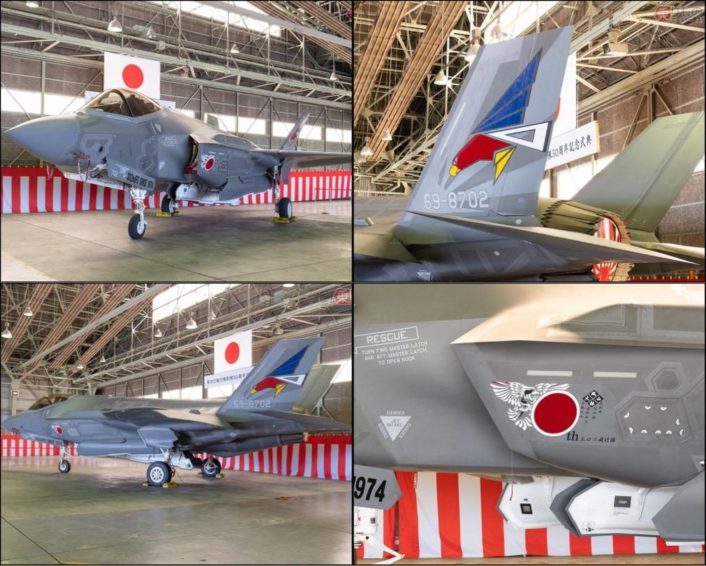The 302nd Squadron selected a local eagle species as its mascot, recognized as Ojirowashi (white-tailed sea eagle), which is native to the mountains surrounding its home base in Misawa. Japan has a rich tradition of painting its aircraft in bold and artistic liveries, particularly the F-15 and retired F-4 fighters, resulting in a remarkable array of vibrant color combinations and designs that captivate onlookers.
The Japan Air Self-Defense Force’s (JASDF) 302nd Squadron (or 302 Hikotai) showcased an F-35A Lightning II adorned with a distinctive and colorful paint scheme for the first time at Misawa Air Base in northern Japan. The F-35A, with the serial number 69-8702, features a striking bald eagle emblem set against a yellow, vermilion, red, white, and blue color palette.
This information, along with images from the unveiling, was shared on the Avia News Telegram channel, coinciding with the squadron’s 50th anniversary celebrations. The 302 Hikotai was originally established on October 1, 1974, at Chitose Air Base in Hokkaido, as the second of the JASDF Phantom squadrons.
No official details have been released by the JASDF regarding the paint job or the unveiling ceremony, but aviation enthusiasts captured several photos of the newly painted fighter at the air base, which were also shared on X. The previously used colored emblem featuring an eagle, complete with wings and talons, was consistent across the squadron’s earlier F-4EJ Phantom IIs.
For the F-35s, the eagle emblem has been incorporated on the tail in the standard gray and light gray color scheme. The new colors highlight specific areas of the eagle design, although due to the limited approval for colorful paints on these aircraft—aimed at preserving their low visibility—there’s a likelihood that the vibrant paint will be removed shortly, returning the jet to its standard colors.
The F-35A and the Paint Job
According to public aircraft registries, the F-35A with serial number 69-8702 was built at the Lockheed Martin Aircraft Systems (LMTAS) facility in Fort Worth, Texas, and made its maiden flight on November 30, 2016. The 302 Hikotaiwas re-established on March 26, 2019, during a ceremony marking its transition from the F-4 Phantom.
平成31年3月26日(火)、
三沢基地で第302飛行隊新編行事が行われました。🌸🎶🎉新時代とともに歴史を紡いでいきます#航空自衛隊#三沢基地#第302飛行隊新編行事 pic.twitter.com/MOkR3Z2Iga
— 航空自衛隊 三沢基地 (@jasdf_misawa) March 26, 2019
During this event, an F-35A flew alongside two older Phantoms from the 302 Hikotai. Notably, one of the F-4s showcased the same tail logo and color theme. Additionally, Misawa Air Base was the site of the JASDF’s first F-35A (89-8706) arrival on January 26, 2018, as confirmed by a U.S. Air Force announcement. The 35th Fighter Wing is also stationed there.
Japan has a long-standing tradition of painting its aircraft in bright and vibrant liveries, particularly for the ‘aggressor’ F-15s, which are known for their remarkable and diverse colors and designs. This tradition extends to the F-4s as well. For instance, The Aviationist reported on a recent repainting of an F-15J/DJ (airframe 12-8074) from the Flight Training Group (Hiko Kyodogun) at Komatsu Air Base, which received a new camouflage paint scheme.

Interestingly, Avia News also shared a collage depicting additional paint jobs on the exterior of 69-8702’s air inlets, which show the JASDF roundel in red (not seen in other images) and the eagle’s wings highlighted with white paint and outlined in black.
However, aircraft spotter ‘ASASHIN/shin_f_eagle’ shared images on X that primarily focused on the tail color and did not reveal changes to the nacelle logo. Despite this, the account provided pictures of 69-8702 from both sides, showing the eagle design on the tails. A retweeted comment from another user noted that the aircraft “wasn’t even finished when it was displayed at the airshow.”
今日はデカオジロに驚かされました✨
左側撮ったら右側も撮らなきゃ…なので結構な雨の中降りてきたデカオジロの右側もご覧下さいませ。 pic.twitter.com/1jyv8Gg9AJ— ASASHIN (@shin_f_eagle) October 2, 2024
This implies that the nacelle coloring may have been completed after the ceremony, with the photos in the collage captured afterward. As noted earlier, there has been no official statement regarding the ceremony or the new paint scheme, but plane spotters have corroborated the initial reports. Specifics about when the paint job was applied and unveiled remain unclear.
JASDF 302 Hikotai’s Tail Markings
According to J-HangarSpace, which records histories and photographs of JASDF squadrons, the 302 Hikotai chose a local eagle species native to the Misawa area as its mascot, known as Ojirowashi (white-tailed sea eagle). The design actually incorporates the unit’s number—the wings signify ‘3’, the tail signifies ‘0’, and the talons represent ‘2’.
#全日本バリ順選手権 pic.twitter.com/tWM3yCGNt3
— ルーシー(旧名 Lusty11) (@lusty_11) September 15, 2020
All of the squadron’s F-4s were embellished with a striking array of vivid, artistic paint schemes while maintaining the same tail marking and color scheme for the F-35A (69-8702), honoring tradition. The designs varied widely, from full airframe themes to specific nose art, like shark mouths and dragon heads, showcasing an incredible range of colors and combinations.
#飛行機を3機一緒に撮りました pic.twitter.com/72DpYvAAFc
— aya01@生きてるだけで儲けもの (@aya01flt) October 4, 2024
According to J-HangarSpace, from its days with the F-4 fighter jets, the 302 Hikotai was the only JASDF squadron allowed to deviate from the standard regulation, which mandates that the tail marking must be smaller and less prominent than the ‘hinomaru’ (national roundel) marking.



